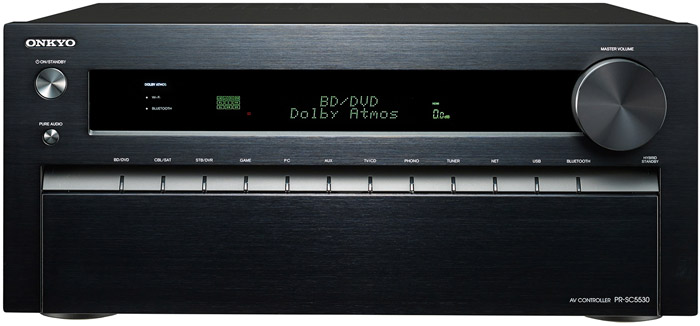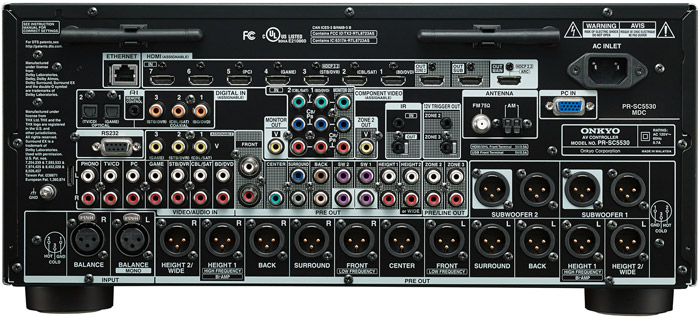This morning, Onkyo announced that select models in its upcoming line of audio/video receivers (AVRs) and home theater in a box (HTiB) systems would feature Dolby's newest surround technology, Dolby Atmos. But even better, the company also revealed that it will enable Dolby Atmos in several of its current midrange receiver models via a firmware update coming later this year. This means consumers will be able to outfit their home theaters with Dolby Atmos surround for under $700 (for the receiver) and they may already own the receiver.
Upcoming Onkyo products which will support Dolby Atmos include two high-end receivers and a new flagship preamp/processor. The TX-NR1030 ($1,699) and TX-NR3030 ($2,399) network A/V receivers, and the PR-SC5530 Network A/V Controller ($2,499) are all currently scheduled to ship to dealers in August. All models include height channels as well as additional channel options: The TX-NR1030 supports up to nine speakers with two subwoofers (9.2) while the TX-NR3030 and PR-SC5530 support up to eleven speakers with two subwoofers (11.2).
Other new products which will feature Dolby Atmos include the HT-S7700 and HT-S9700THX HTiB systems, and the SKS-HT693 and SKH-410 speaker packages. Details on pricing and expected availability of the HTiB systems and speaker packages were not available at press time.
Onkyo receivers in the current line that will add Dolby Atmos support include the the TX-NR636, TX-NR737, and TX-NR838 networked home theater receivers. Each of these receivers already includes the option for height channels, a critical component of Dolby Atmos. Onkyo is currently expecting to make the Dolby Atmos firmware update available in September of this year.

Dolby Atmos is more than just "more channels" than its predecessors or competitive surround formats: it is an object-oriented surround platform. Dolby does add discrete height channels into the mix, which can add a new level of immersiveness, but it's the way that sound is encoded and decoded that sets it apart from other surround formats. Dolby Atmos encodes specific sounds with meta data which defines where the sound exists precisely in three dimensional space.
In the old channel-based systems, sound positions are effectively hard-coded into the mix. For example, If a sound is supposed to travel from left to right of the rear of the soundstage in an existing 7.1-channel DTS or Dolby mix, the rear left channel will start loud and fade to soft while the rear right channel starts soft and becomes louder. This can create a convincing illusion of movement but it is neither efficient, nor precise. With Dolby Atmos, each sound effect can be stored discretely, along with control code that defines the sound's starting and ending position as well as speed of movement and amplitude. At playback, the Dolby Atmos decoder creates a real-time downmix to place each discrete sound as precisely in space as it can, given the available speakers. This allows film-makers to create a single soundtrack for a film and be sure that it is rendered as realistically as possible, whether the theater (or your home theater) has 7 speakers, 24 speakers or even 64 speakers.

We first heard Dolby Atmos in May 2012 at Dolby's San Francisco labs, just before the first theatrical film (Disney's "Brave") was released in the format, and we were impressed. Since then, over 100 theatrical films have been encoded in Dolby Atmos, including Blockbusters such as "Godzilla," "Edge of Tomorrow" and the upcoming "Transformers: Age of Extinction" as well Oscar-winners, "Life of Pi" and "Gravity." "Gravity" was one film that significantly benefitted from the Dolby Atmos treatment as it allowed the director and sound designers to create a truly immersive surround soundscape, bringing viewers right into the action. In addition to winning Best Picture, the film took home several Oscars in the sound and mixing categories.
Neither Onkyo nor Dolby has announced yet how consumers will get their hands on actual software (movies or music) which have been encoded in Dolby Atmos. The current Blu-ray spec does not support Dolby Atmos, nor have any online streaming providers announced support for it yet. But we imagine these details will be fleshed out over time.
UPDATE: In his latest blog post (which was not yet live when we completed this article), Dolby's Director of Sound Research Brett Crockett has stated that the current Blu-ray spec (and players) support Dolby Atmos via bitstream output. We're not sure how this is possible as Dolby Atmos is not one of the supported audio formats in the current Blu-ray Disc spec. While it may be possible to embed a raw Dolby Atmos stream onto a Blu-ray Disc and output this via bitstream to a compatible decoder, I'd be very curious what an existing Bluray player would do with this unrecognized format. We'll try to get some additional details on this for a follow-up article in the near future.
UPDATE 2: Based on some preliminary conversations with the hardware vendors, it looks like Dolby Atmos is being encoded into Dolby TrueHD and Dolby Digital Plus soundtracks, which would make it compatible with existing Blu-ray and streaming formats. We'll publish more as we find out more.
More Information: